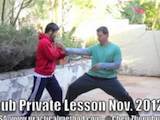Master Chen Zhonghua’s teaching recording on the principle of not moving the body while doing taiji. This is part of his lectures to the full time students on Daqingshan during the 2011 Daqingshan Hong Junsheng Taijiquan International Conference and Competition. Author: Chen Zhonghua Length: 52 min. In: Chinese Year: 2011 Difficulty:3/5 At:Daqingshan Mountain Resort for Taiji
“Don’t Move: Chen Zhonghua Lecture at the 2011 Daqingshan Hong Junsheng Taijiquan International Conference and Competition” Online Video Trailer
Previous post: Feeling the energy on champions
Next post: DQS Lesson: Elbow In Hand Out



{ 3 comments… read them below or add one }
The clip is in Mandarin chinese so having someone nearby to translate would be helpful. Otherwise keep in mind as the title states “Don’t Move” and you should be able to get the gist of it. Hoping that the chinese clips posted will have subtitles inserted at a later time.
The next closest thing to being at Daqingshan to absorb the teachings and atmosphere of learning is to watch this video. This video is more suitable for those who are not familiar with Master Chen’s teachings. However, for the intermediate and even advanced there are many subtleties (and reminders) that are precious enough to end up getting and keeping this video. Aside from the main theme of “Don’t Move” there is a substantial part of this 52 minute video on the key principles of “Open Kua, Withdraw Shoulders, and Out with Hand”. There is even an exercise on how to train with a partner on “Don’t Move”. Please note that this video is not a production in the form of a formal instructional program. It is a close-up recording of the instructions and teachings as well as Master Chen’s celebrated hands-on that are an integral part of the training at Daqingshan. The video quality and camera positions are very good. [At the time of this writing, the video is in Mandarin with only a few subtitles in English.]
This video provides viewers with a very accurate taste of what it is like training on the mountain (Daqingshan) in Shandong, China. The methodologies of teaching and interactions between master and students can be virtually experienced with different groups of participants from all over China and abroad as well. The detailed explanations that are interspersed throughout the 52-minute video are very useful for both beginners and intermediate practitioners alike. The video quality and angles are of high quality.